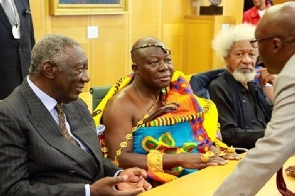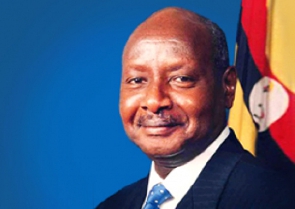Politics of Tuesday, 27 November 2012
Source: Kelvin Dartey
CODEO release final Statement on nationwide BVR exercise

The Coalition of Domestic Election Observers (CODEO) has in a report revealed that equipment malfunction of biometric voter registration equipments was the most common of the challenges encountered during the BVR exercise.
Some of the recorded challenges include Registration kit malfunction, including login difficulties, screen freezes and printer breakdowns; which nearly marred the beauty of the process.
The report was made public at a press briefing on Tuesday in Accra.
Below is the full report
Introduction
For the 2012 elections, CODEO has conducted a comprehensive observation of the BVR process since the exercise was initiated by the EC on the 24th March 2012. CODEO’s findings on the BVR exercise have been progressively disseminated to key stakeholders, the media and citizens of Ghana through the three reports released over the four phases of the registration exercise. CODEO released its preliminary statement on the observation as a press release on the 27th March 2012. The preliminary report was based on the first phase observation of the BVR exercise by 50 roaming CODEO field observers across the 10 regions of the country.
The two reports that followed the preliminary statement were issued as media briefings. The first media briefing was held on the 24th April 2012, and covered the interim findings up to the end of the second phase of the registration process. The second media briefing was held on the 17th May 2012 at the end of the fourth and final phase of the BVR, and covered the provisional findings at the conclusion of the registration of all eligible Ghanaian voters ahead of the 2012 polls. The aim of today’s briefing is to share with the Ghanaian public, through the media and other key stakeholders, the final CODEO observation findings on the entire BVR exercise considering that the voter registration process has run its full course and the voter register has been certified by the EC.
Furthermore, since the release of the provisional statement, CODEO has observed the district registration review committees and the exhibition of the provisional biometric voters register. These new observations, as well as an experiential survey conducted during the registration period to seek the views of registrants on the whole BVR exercise, are included in this final statement.
CODEO and the 2012 BVR Observation Project
The goal of CODEO’s BVR observation was to promote a credible voter registration in Ghana, which is accurate and will contribute to peaceful election outcomes. With the generous assistance from the United Kingdom Department of International Development (DfID):
CODEO recruited, trained and deployed a total of 650 of its members to observe the entire BVR registration exercise. This observation covered a random sample of 600 registration centers drawn from 300 Electoral Areas in 100 districts in all 10 regions of Ghana. In order to obtain a nationally representative sample, key consideration was given to the total number of registration centers in each of the 10 Regions in the country and the same was repeated at the regional, district and electoral area levels. This allowed CODEO to obtain a true picture of the BVR exercise nationwide over the four phases of the exercise.
CODEO also observed the registration of prisoners at the Kumasi Central, Nsawam, Akuse, Ankaful, Bawku and Navrongo prisons, which took place on 24th May 2012.
CODEO observed the limited mop-up registration exercise in 24 out of the 187 registration centers where the exercise took place. This was carried out on 9th June 2012.
Furthermore, CODEO deployed its observers to report on the work of 28 District Registration Review Committees (DRRCs) set up by the EC to investigate challenge applications filed during the registration exercise. Findings of this observation were first shared with the public on 28th June 2012.
The voter register exhibition exercise, which was carried out by the EC from the 1st - 10th September 2012, was also observed by 54 of CODEO’s observers. The observers were deployed to all ten regions of the country, and at the end of the 10-day exercise, the observers had covered a total of 644 exhibition centers.
Finally, CODEO observed the national pilot biometric verification exercise organized by the EC on 3rd – 4th November in selected polling stations across the country, with CODEO observers deployed in the Northern, Eastern, Central, Ashanti and Volta Regions.
Registrants Experiential Survey
As part of the overall observation of the BVR exercise, CODEO also undertook an awareness and experience survey of challenges registrants faced during the registration period. The trained observers that were deployed from 24th March to 5th May 2012 to observe the BVR exercise conducted a series of face-to-face interviews with randomly selected registrants in sampled polling stations across the country. A two-stage stratification method was used to sample constituencies and polling stations from the EC’s 2012 constituency and polling stations database for the survey. As a result, 8000 respondents were surveyed from over 200 registration centers located in 80 constituencies across the country.
CODEO General Findings from Observation of the BVR Exercise
• Opening and Closing of Registration Centers
Observers reported that the majority of centers opened shortly after the appointed time of 7am. Approximately half of the observed registration centers closed at the scheduled time of 6pm or beyond, and the other half closed early. Technical faults, equipment breakdown and late arrival of staff were the main contributing factors and as these challenges became more frequent in the last two phases of the exercise, so did the early closure and late openings of registration centers. In the final phase of the exercise, technical issues and shortage of registration materials resulted in some centers completely closing until the problem was addressed.
• BVR Equipment
BVR equipment malfunction was the most common of the challenges encountered during the BVR exercise. Registration kit malfunction, including login difficulties, screen freezes and printer breakdowns were experienced. Technical challenges lasted for hours in some cases and wasted considerable time for the registrants who had to visit the centers more than once. In total, approximately 8 percent of registration centers recorded some form of equipment malfunction. Very little was done to address these technical challenges in the most affected areas, and resulted in the suspension of registration. However, CODEO observed only a few minor incidents of equipment breakdown during the registration of prisoners and during the mop up exercise, leading CODEO to conclude that the exercise had run relatively smoothly.
• Registration Officials and Supervisors
CODEO observers reported that a significant number of registration centers were without the required number of registration officials. Only around half of the centers observed had the correct number of EC personnel present during the exercise. Observers reported a number of registration official inadequacies, including inadequate or lack of conversance with the operation of the biometric kits, which negatively affected the pace of the registration. Observers also recorded inadequate supervision of centers by EC monitors, with around 61 percent of EC registration officers going unsupervised. Only a third (33 percent) of CODEO observers indicated the presence of EC monitors over the period of the exercise.
• Registrant Turn Out
Turn out for the main BVR exercise was lower in rural areas as a result of registrants being inadequately informed about the registration exercise in general, and the cluster system in particular. Turn out was reportedly low for the prisoner registration, the exhibition of the register and the pilot BVR exercise. However, observers noted that the two exercises (the exhibition of the register and the pilot BVR), on the whole, took place smoothly. Observers attributed the low turn out to insufficient public awareness and inability to locate centers. Turn out for the mop up exercise was mixed with some centers reporting high attendance.
• Voter ID Cards
Shortage of materials at some registration centers meant that capturing the bio data and issuing voter ID cards to registrants could not be carried out, making it necessary therefore to make repeat visits to EC offices. Those that did receive cards found that photographs were generally of good quality, but there were a few instances where photographs were blurred or quite dark. CODEO observers reported that prison officials kept voter ID cards issued to the registrants, ostensibly on behalf of their owners.
• Challenging Ineligible Registrants and the DRRC Process
CODEO observed that during the main registration period in some centers, the identity of registrants was not checked and eligibility criteria were not strictly adhered to. Identification documents or guarantors were not demanded at some polling centers, especially in rural areas and smaller urban communities. CODEO observed, however, that procedure was followed properly in most cases where the eligibility of registrants was challenged. In other cases, those who challenged the eligibility of prospective registrants demonstrated poor understanding of the eligibility criteria for registration, particularly criteria related to residency, age, identification and procedures for guarantors and challenges, with around 22 incidents of registration of minors recorded.
In the last phase of the main registration exercise, CODEO observed that EC officials followed a stricter procedure to lodge protests against registrants suspected to be ineligible. They employed more assertiveness and insisted that challengers complied with the procedure. CODEO observers reported that the District Registration Review Committees largely followed the laid down procedures for reviewing challenge applications filed during the registration exercise. Political party agents filed most of the challenge applications, often made on the basis of age, residency, and nationality. CODEO also observed that several people could not appear before the DRRCs due to difficulties on the part of the EC in contacting them.
• Exhibition of the Provisional Voter Register
During the exhibition of the register, CODEO observed that registers had incorrect/inconsistent registration details for some registered voters. Most incorrect registration details related to incorrect spelling of names, inconsistencies in voter ID numbers, changes in sex of registered voters, and differences in ages. However, the problem of registered names missing from the registers was generally not widespread. The exhibition exercise could not take place at a small number of centers due to the non-availability of the voter register for the affected centers. CODEO observed that the EC however, made arrangements for a late exhibition exercise in the affected areas.
• Pilot BVR and Verification Exercise
CODEO observers for the voting verification and pilot BVR exercise reported that the verification device was easy to operate, and that the pace of the entire voting process and verification was fast. CODEO observed no instances of device failure. However, reported isolated cases of rejected fingerprints in some of the observed stations (1-2 per polling station) were subsequently addressed by rigorously cleaning voters’ fingers to ensure acceptance by the device.
• Violent Incidents and Police Action During BVR Exercise
On the whole, CODEO observers reported generally low incidence of violence during the 2012 registration. The vast majority of incidents that CODEO observers reported on occurred during the main BVR exercise, and manifested in violent attacks, assaults, intimidation and harassment of EC officials with respect to attempts at registering ineligible voters, marauding thugs on unregistered motorbikes, and property destruction, including that of registration kits. Physical abuse, confrontations and restraint of those suspected to be ineligible were typical responses to instances of EC and party officials challenging eligibility. CODEO observers did not report any incidence of violence in the prisoner registration or mop up exercises.
Similarly the exhibition of the provisional biometric voters’ register was generally peaceful and incident free. However, CODEO observers noted a few confrontations resulting from non-adherence to the Review Committees decisions. Police Action on Violence Incidence CODEO continues to follow up on the status of police investigations and prosecution of some of the violent incidents recorded during the BVR exercise. CODEO has observed police action in response to some of the incidents reported in Phases 1and 2 of the BVR exercise. CODEO’s checks indicate that while Police investigations of some of the cases have been completed and dockets sent to the Attorney General’s office, CODEO is still seeking updates from the Police on others. The cases that CODEO is following up include incidents that occurred in the West Mamprusi and Asunafo South Districts, Tafo-Pankrono, Tain and Odododiodio Constituencies (See Appendix A).
Experiential Survey: What do Ghanaians Say about the BVR Exercise? The Experience of Registered Voters The experiential survey of the conduct of the BVR was aimed at gathering registrants’ opinions and impressions about the BVR exercise. From the 8000 registrants surveyed, CODEO observed the following:
• Registrants got information on the BVR from multiple sources. However, out of the multiple sources, radio (40%), followed by family and friends (20%) and television (19%) turned out to be the top three sources.
• Furthermore, most registrants were adequately informed about the dates of registration in their communities, with nearly nine out of ten (87%) responding in the affirmative.
• However, the location of registration centers was not adequately communicated, with a sizable minority (26%) of registrants not having access to this information.
• Proving one’s identity did not pose any difficulty for the vast majority of Ghanaians, with a national average of 88% managing to provide proof of national identity, often using their old voter identity card as proof. EC officials permitted around 2% of registrants to use unofficial documents to prove their identity. Overall, an overwhelming majority of respondents successfully obtained new voter ID cards in nearly all cases (99%).
• Registration officials offered extra assistance to most of the registrants who needed it (65%). However, about a third who needed support did not receive any, including people with disabilities, elderly and pregnant women.
• The registration officials received a positive rating for their control over the process, with 92% of registrants rating them favourably.
• Although equipment malfunction was one of the biggest challenges to registration observed by CODEO, the survey showed that in general, equipment was largely reliable, with around 87% claiming it never broke down.
• Registrants largely believe there is a vast difference between the BVR and traditional methods of voter registration. Additionally, over three-quarters of respondents (78%) agreed the biometric registration was far better than the traditional system of voter registration, and was further commended by 87% of respondents for being a useful tool for promoting credible and peaceful elections.
• Overall, the BVR experience survey confirmed a highly positive public response to the BVR exercise. The majority of registrants believe that they were given adequate notice of the exercise and were able to quickly and successfully obtain their new voter ID cards. The survey suggests the technological equipment used was able to quickly and accurately capture the fingerprints and images of respondents.
CODEO’s Concluding Remarks on the BVR Exercise Based on the findings above, and consistent with CODEO’s conclusions in the previous reports, CODEO expresses its broad satisfaction with the conduct of the Biometric Voter Registration (BVR) exercise. CODEO can broadly confirm (with satisfaction) that majority of the Ghanaian voting public readily heeded the call to register. CODEO notes that the introduction of the biometric register was expected to help minimize, if not totally eliminate, the challenge of double or multiple registrations and voter impersonation that had bedevilled our electoral process over the years.
CODEO is aware of the efforts of the EC to expunge double or multiple voters in the register. However, the reported cases of possible underage voters who still remain in the certified voters’ register is a worry for CODEO. CODEO supports the call by the EC for minors to stay away from the polling station on election-day. CODEO further calls on all political parties to educate their supporters, and entreat them to discourage minors from voting on election day. Similarly, parents and guardians must advise their underage registered children and wards to desist from voting.
CODEO is of the view that while the Biometric Voter Register may not be a perfect document, its quality is substantial and therefore an improvement that would contribute to credible and peaceful 2012 elections. CODEO commends all Ghanaians, the Electoral Commission of Ghana, the Ghana Police Service, and civil society organizations for their role in helping to bring this phase of the electoral process to a completion.
Nonetheless, CODEO respectively requests that the EC soon fulfils its promise to furnish the political parties with copies of the BV register for all regions. Recommendations Notwithstanding CODEO’s positive findings on the biometric voter register, and based on the findings of its comprehensive monitoring of the BVR exercise, CODEO recommends the following in the lead up to the December 7 polls: To the Electoral Commission:
To prevent a national crisis in the days ahead of the December 7 polls, the EC must take extra care to provide adequate protection from the weather and any conditions that will cause the breakdown of the verification equipment;
The EC must ensure the provision of adequate back-ups at all polling stations and the presence of the needed technical assistants;
The EC must ensure that its staff is properly trained in the use and management of the verification equipment on election-day to avoid unnecessary delays and equipment malfunction;
The EC must intensify the dissemination of information through media outlets, particularly radio, to increase voter/public awareness on the use of verification equipment on polling day so as to bolster confidence in the verification process and use of the biometric register;
The EC must publish in the newspapers/media the names and photos of all declared offenders of multiple registration and declare them expunged from the BV Register. To the Ghana Police Service and Relevant Stakeholders:
CODEO calls on the Ghana Police Service and the Attorney General Department to speed up the investigations and prosecution of alleged perpetrators of violence during the BVR exercise. This process must be publicized to send a message of non-tolerance of violent behavior to the public and also to enhance public confidence in the justice administration institutions of the state. CODEO will continue to monitor the progress of action against these offenses and other future cases.
To the Electoral Commission in the post-December 7 polls:
The EC must take steps (working with the Ghana Police Service) to prosecute those who were deliberately involved in multiple registration during the BVR exercise. It is critical that those who knowingly commit electoral offence be investigated and punished in order to serve as a deterrent to others.
CODEO and December 7 Election Day CODEO is in the final stages of training and deployment of approximately 4000 of its members to selected polling stations throughout the country on December 7. CODEO will once again undertake the Parallel Vote Tabulation (PVT) methodology on December 7.
The PVT methodology (which was successfully pioneered in the 2008 polls) will enable CODEO to verify the accuracy of the Presidential results as declared by the EC. CODEO will brief the media again on December 5 on its preparations to observe the December 7 polls. Thank you. You may now want to discuss these issues or ask for clarifications. Prof. Miranda Greenstreet Co-Chair, CODEO Dated: November 27, 2012.










